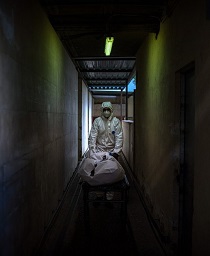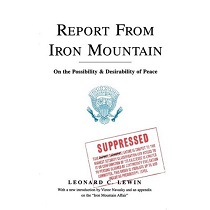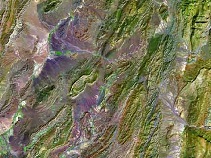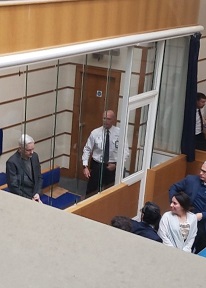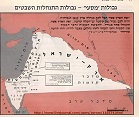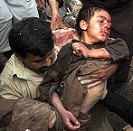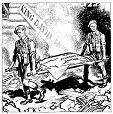False Flag Attacks: The “Strategy of Tension” in the Cold War Period
Daniele Ganser
The “Strategy of Tension” in the Cold War Period *
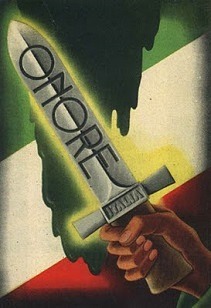
Historians today and in the coming years face a challenging task: they must write the history of the events of September 11, 2001. What they write will be taught in history classes. But what will they write? Will they write that Osama Bin Laden sent 19 Muslims to launch a surprise attack on the U.S.? Or will they write that the administration of President George W. Bush was responsible for the attack, either constructing it or deliberately permitting it in order to shock the U.S. population and to create a pretext for increasing military spending and attacking Afghanistan and Iraq?
Having examined much of the data related to the 9/11 events, I am convinced a new and thorough investigation is needed. But when I have questioned the official narrative of 9/11 in my native Switzerland I have encountered vigorous objections from people. Why would any government in the world, they have asked, attack its own population or, only slightly less criminal, deliberately allow a foreign group to carry out such an attack? While brutal dictatorships, such as the regime of Pol Pot in Cambodia, are known to have had little respect for the life and dignity of their citizens, surely a Western democracy, the thinking goes, would not engage in such an abuse of power. And if criminal elements within a Western democracy, in North America or in Europe, had engaged in such a crime, would not elected officials or the media find out and report on it? Is it imaginable that criminal persons within a government could commit terrorist operations against innocent citizens, who support the very same government with the taxes they pay every year? Would nobody notice? These are difficult questions, even for academics who specialize in the history of secret warfare. But in fact, there are historical examples of such operations being implemented by Western democracies.
In this essay, I will not deal directly with 9/11 but will look at what we can learn from history. I will report on some of the newest academic data about secret warfare during the Cold War. A secret military strategy that targets domestic populations with terrorism does indeed exist. It is called the “strategy of tension.” And it was implemented by Western democracies.
The Strategy of Tension
It is probably fair to say that of the roughly seven billion people who live on our planet today, far less than one percent has ever heard of the “strategy of tension.” And only a very few of these could illustrate the strategy with specific historical examples. It is indeed a strategy of a shadow world, known only to a few military and intelligence officers (and some criminals) who have carried it out, a few police officers and judges who fought against it, and a handful of journalists and academics who have written about it.
In its essence, the strategy of tension targets the emotions of human beings and aims to spread maximum fear among the target group. “Tension” refers to emotional distress and psychological fear, whereas “strategy” refers to the technique of bringing about such distress and fear. A terrorist attack in a public place, such as a railway station, a market place, or a school bus, is the typical technique through which the strategy of tension is implemented. After the attack—and this is a crucial element—the secret agents who carried out the crime blame it on a political opponent by removing and planting evidence.
It must be noted that the targets of the strategy of tension are not the dead and the wounded of the terrorist attacks, as many might assume. The targets are the political opponents, who are discredited through the attack, and those who remain unharmed but learn of the attack, thereby coming to fear for their lives and those of their loved ones. Since the aims of the strategy are to discredit opponents and to create fear, the real targets are not the people who were killed, whether they number in the dozens or even thousands, but the millions of people who survive physically unharmed but emotionally distressed.
The strategy of tension forms part of what is called “psychological warfare” or PSYWAR. As the term indicates, this form of warfare does not attack human bodies, tanks, planes, ships, satellites, and houses in order to destroy them, but human psyches, human minds. Leaving aside the fact that philosophers, psychologists, neurologists, and theologians have never been able fully to agree on exactly what “the mind” is, we can for our purposes here define it simply as our human ability to think and feel. If a group can get access to our thinking and our feeling without our noticing, it can exercise great power over us. Once we notice that our psyches are being manipulated through psychological warfare, the technique loses some of its effect.
Psychological warfare played a central role in World War II and all the wars that followed. It was used by military leaders in Europe, the Americas, Asia, Australia, and Africa. It is sometimes popularly referred to as “propaganda,” but propaganda is only one form of psychological warfare. The strategy of tension is a lesser known form. The US Department of Defense defines psychological warfare as: “The planned use of propaganda and other psychological actions having the primary purpose of influencing the opinions, emotions, attitudes, and behavior of hostile foreign groups in such a way as to support the achievement of national objectives.”1
Psychological warfare can come in many different and seemingly unrelated forms—leaflets, posters, or television reports, all designed to shape the thinking and feeling of the target group. Or it can come in the form of a terrorist attack carried out by secret agents and blamed on a political opponent. Needless to say, strategyof- tension terrorism that kills innocent people is a much more radical and brutal form of psychological warfare than dropping paper leaflets from a plane over enemy territory. But the two forms of psychological warfare are linked in their targeting of the mind—the emotions and thoughts of people.
I will now give some historical examples of strategy-of-tension terrorism. Arguably the best historical data available today on the strategy of tension come from Italy, where judges, parliamentarians, and academics together continue to make great efforts to understand and describe this secret strategy.
Judge Casson and the Peteano Terror
Italian Judge Felice Casson rediscovered the strategy during his investigation into a number of terrorist attacks Italy had suffered in the 1960s, 1970s, and 1980s. According to Casson, the best documented historical case in which the strategy of tension was implemented occurred in the Italian village of Peteano. There, on May 31, 1972, three members of the Italian paramilitary police, the Carabinieri, were lured to an abandoned Fiat 500 by an anonymous phone call and were killed when they opened the hood of the car, thereby triggering a bomb. For many years, this terrorist attack was blamed on the Red Brigades, a left-wing terror organization in Italy. But after Casson reopened the case, he found that the Catholic neofascist Vincenzo Vinciguerra, a militant anti-communist, had carried out the crime.
Casson also found to his great surprise that Vinciguerra had not operated alone, but had been protected by members of the Italian military intelligence service, today called SISMI (Servizio per le Informazioni e la Sicurezza Militare).2 Judge Casson arrested Vinciguerra, who on trial in 1984 confirmed that it had been relatively easy for him to escape and hide because large segments of the Italian security apparatus, including the SISMI, had shared his anti-communist convictions and had, therefore, silently supported crimes that discredited the Italian left and especially the Communist Party, which was quite strong. After the bombing, Vinciguerra recalled, “A whole mechanism came into action.... [T]he Carabinieri, the Minister of the Interior, the customs services, and the military and civilian intelligence services accepted the ideological reasoning behind the attack.”3
Casson found that by this crime and other attacks being blamed on the leftwing Red Brigades, the primary political enemy, the Italian Communist Party, was discredited. The directors of the military intelligence service and politicians argued after the crime that the “Communist danger” justified increased military spending and a reduction of civil liberties in the interest of state security. In this way, the strategy of tension, as executed through the Peteano terror, spread fear across Italy, discredited a political opponent, and allowed for the implementation of conservative security policies. It was very effective, for nobody knew at the time that the intelligence services had themselves supported the crime.
“As far as the intelligence services are concerned, the Peteano attack is part of what has been called ‘the strategy of tension,’” Judge Casson explained in a BBC interview in 1991.
The tension created within the country then served to promote conservative, reactionary social and political tendencies. While this strategy was being implemented, it was necessary to protect those behind it, because evidence implicating them was being discovered. Witnesses withheld information to cover right-wing extremists.4
Vinciguerra was a member of a private Italian fascist organization, Ordine Nuovo (New Order), which cultivated close relations with the SISMI. A fellow Ordine Nuovo member, Clemente Graziani, argued in a 1963 book that as Catholics it was their duty to fight the godless Communists by all means, including strategy-oftension operations that, at first glance, might seem too brutal and immoral. The Communists also engaged in dirty tricks, he argued, and therefore would never be defeated if Ordine Nuovo for moral reasons shied away even from terrorism: “Terrorism obviously has the possibility to kill or let [be] kill[ed] also elderly people, women and children,” Graziani noted. But, he continued:
Operations of this kind have until now been considered to be contemptible and despicable crimes, and above all, useless crimes to win a conflict. The revolutionary warfare canon however subverts these humanitarian and moral principles. These forms of terrorist intimidation are today not only considered as acceptable operations, but are at times even absolutely necessary.5
Other Terrorist Attacks
Peteano was not an isolated tragedy in Italy, but part of a long series of terrorist attacks that had started in 1969. On December 12 of that year, four bombs exploded in public places in Rome and Milan, killing 16 and maiming and wounding 80 innocent civilians, with most of the deaths and injuries occurring in Milan’s Piazza Fontana. After the massacre, according to the rules of the strategy of tension, the Italian military intelligence service SID planted bomb parts in the villa of well-known leftist editor Giangiacomo Feltrinelli in order to blame the terror on the Communists and other members of the extreme left.6 Only years later was it revealed that Feltrinelli had absolutely nothing at all to do with the crime and that, in reality, the Italian extreme right, including Ordine Nuovo, had carried out the atrocity in order to promote the strategy of tension.
Major attacks came in 1974, a couple years after the Peteano tragedy. On May 28, a bomb exploded at an anti-fascist rally for which 3,000 had gathered in the Italian city of Brescia, killing 8 and injuring and maiming 102 people. To cover the traces of the right- wing bombers, the square was cleaned with water hoses before the investigating magistrates could reach the scene of the crime to secure the evidence. An Italian Senate commission later observed that “the investigations immediately after the massacre were characterized by such incredible mistakes that one is left speechless.”7 Then on August 4, a bomb exploded on a train, the Rometo- Munich Express, killing 12 innocent civilians and injuring and maiming 48.
The most deadly attack came in 1980, on the afternoon of Saturday, August 2, a warm and sunny day that was also the first full day of the Italian national summer holiday. A massive explosion ripped through the second class waiting room at the Bologna railway station, killing 85 people in the blast and seriously injuring and maiming a further 200.
The Purpose of the Attacks
This series of terrorist attacks discredited the Italian Communists and spread maximum fear among the Italian population, as nobody really knew what was going on and who would be killed next. It was impossible to protect the entire transportation system, let alone all public places, and thus it was clear to all security experts at the time that democratic societies would always remain vulnerable to terrorist attacks. “You had to attack civilians, the people, women, children, innocent people, unknown people far removed from any political game,” the neofascist Vincenzo Vinciguerra said after his arrest, explaining the strategy of tension in which he himself had participated.
The reason was quite simple [he continued]. They were supposed to force these people, the Italian public, to turn to the State to ask for greater security. This is the political logic that lies behind all the massacres and the bombings which remain unpunished, because the State cannot convict itself or declare itself responsible for what happened.8
The Gladio Revelations
Italian Judge Felice Casson, who had rediscovered the strategy of tension, wanted to know why persons within the Italian government and intelligence services had supported the criminal strategy of tension. Following the arrest of Peteano bomber Vinciguerra, he decided to dig deep. “I wanted that new light should be shed on these years of lies and mysteries, that’s all. That Italy should for once know the truth.”9 In the summer of 1990, Judge Casson requested permission from Italian Prime Minister Giulio Andreotti to search through the archives of the Italian military intelligence service (SISMI) in Rome.
The permission was given and Casson made a sensational discovery: He found that under the code name “Gladio” (“sword”), a secret army existed that had been set up by the Italian military intelligence service in close collaboration with the CIA in the years after World War II. This secret army was to function as a guerrilla unit in the event of a Soviet invasion and occupation of Italy.
The data found by Casson suggested that this mysterious Gladio army was linked to NATO and, in the absence of a Soviet invasion, seems to have manipulated Italian politics in a number of covert action operations during the Cold War in order to weaken the Italian Communists.
Casson confidentially informed an Italian parliamentarian commission of his far-reaching findings. The senators were greatly surprised and, on August 2, 1990, ordered the head of the Italian executive, Prime Minister Giulio Andreotti, “to inform the parliament within sixty days with respect to the existence, characteristics and purpose of a parallel and occult structure that is said to have operated within our secret service of the military with the aim to condition the political life of the country.”10
On October 24, 1990, Andreotti handed a ten-page report entitled “The Socalled ‘Parallel SID’—The Gladio Case” to the Senate investigative commission under Senator Gualtieri. Andreotti’s report confirmed that a secret army existed within the military intelligence service under the code name Gladio. Andreotti added that it was still active and operational. Unwilling to shoulder the far-reaching accusation of conspiracy alone, Andreotti insisted on the same day in front of parliament that “each chief of government has been informed of the existence of Gladio.”11 This announcement compromised, among others, former socialist Prime Minister Bettino Craxi (1983–1987) and above all Francesco Cossiga, a former prime minister (1978–1979), who in 1990 was acting president. The high- ranking magistrates were forced to take a stand. Craxi claimed that he had not been informed, until he was confronted with a document on Gladio that he himself had signed as prime minister. Cossiga said that he was “proud of the fact that we have kept the secret for 45 years.”12
In his report, Andreotti confirmed the findings of Casson and explained that Gladio was the Italian branch of a secret stay-behind army that had been set up after World War II by the CIA and SIFAR as part of an international network of clandestine resistance within NATO countries to confront a potential Soviet invasion. In case of invasion, the stay-behind armies would set up a resistance movement and operate behind enemy lines. These stay-behind armies were supervised and coordinated by two secret unconventional-warfare centers of NATO named the Allied Clandestine Committee (ACC) and the Clandestine Planning Committee (CPC). In Andreotti’s words:
Once the clandestine resistance organisation was constituted, Italy was called upon to participate... in the works of the CCP (Clandestine Planning Committee) of 1959, operating within the ambit of SHAPE [NATO’s Supreme Headquarters Allied Powers Europe]...; in 1964 the Italian intelligence service also entered the ACC (Allied Clandestine Committee).13
Facing sharp protests from the Italian press, Andreotti claimed that the Italian military intelligence service in general, as well as the Gladio members in particular, had nothing to do with the terror from which Italy had suffered during the Cold War. He said that “the pre-selected subjects do not have a penal record, do not partake in active politics, nor participate in any sort of extremist movement.”14
Peteano bomber Vinciguerra, who had been at the heart of the strategy of tension, disagreed with this account. Already during his trial in 1984, he had declared: “With the massacre of Peteano and with all those that have followed, the knowledge should by now be clear that there existed a real live structure, occult and hidden, with the capacity of giving a strategic direction to the outrages.” The structure, he said, “lies within the state itself. There exists in Italy a secret force parallel to the armed forces, composed of civilians and military men, in an anti- Soviet capacity, that is, to organize a resistance on Italian soil against a Russian army.”
Without revealing the name Gladio, Vinciguerra had clearly been speaking of the secret army many years before Prime Minister Andreotti confirmed its existence. Vinciguerra said in 1984 that what he was describing was “a secret organization, a super- organization with a network of communications, arms, and explosives, and men trained to use them.” Vinciguerra insisted that this “superorganization, lacking a Soviet invasion, took up the task, on NATO’s behalf, of preventing a slip to the left in the political balance of the country. This they did, with the assistance of the official intelligence services and the political and military forces.”15
Former heads of the Italian military intelligence were shocked that Prime Minister Andreotti had revealed what many considered to be one of its best kept secrets. General Vito Miceli, chief of the Italian military intelligence service from 1970 to 1974, protested to the Italian press: “I have gone to prison because I did not want to reveal the existence of this super secret organization. And now Andreotti comes along and tells it to Parliament!”16
The Italian press was very critical of the Gladio revelations and the fact that the CIA had played a central role in the secret operation. The daily La Stampa commented:
No raison d’état could be worth maintaining, covering up, or defending a secret military structure composed of ideologically selected members—dependent upon, or at least under the influence of, a foreign power—that allegedly serves as an instrument of political struggle. It cannot be defined as any less than high treason and an attack on the Constitution.17
With this mysterious Parallel SID, conjured up to head off an impossible coup by the left, we have seriously risked making a coup d’état by the right possible.... We cannot accept that... this super- SID was passed off as a military instrument destined to operate “in case of enemy occupation.” The true enemy is only and has always been the Italian Communist party, i.e. an internal enemy.18
The Role of the CIA
In the United States, the story was ignored by the mainstream media. In one of the very few articles on the subject, the Washington Post — under the headline “CIA Organized Secret Army in Western Europe; Paramilitary Force Created to Resist Soviet Occupation” — reported that an unnamed intelligence officer familiar with Gladio had declared that it was “solely an Italian operation. We have no control over it whatsoever.... If there are allegations that the CIA was involved in terrorist activities in Italy, they are absolute nonsense.”19
It is extremely difficult to research and clarify the details of strategy-oftension operations, as nobody is willing publicly to confirm that he or she either ordered or participated in secret terrorist operations that killed innocent civilians, spread fear among a target group, and were wrongly blamed on a political enemy. If, as in the case of Italy, a number of different intelligence services are involved, including the Italian SISMI and the American CIA, then the matter becomes even more difficult, as the different services accuse and contradict each other.
In contrast to the anonymous US intelligence officer quoted in the Washington Post, who implicitly blamed the Italians for the terror in their country, researcher Philip Willan argues that blame belongs to the US government and its intelligence community:
It is by no means easy to determine who was responsible for day to day tactical decisions in the running of the strategy of tension. But there can be little doubt that overall responsibility for the strategy lay with the government and the intelligence services of the United States... [Q]uestions will remain about the adoption of methods that brought violent death to hundreds of innocent victims.20
During a television interview in Italy in 1990, Admiral Stansfield Turner, director of the CIA from 1977 to 1981, was unwilling to confirm this claim of Willan and strictly refused to answer any questions about Gladio. Out of respect for the victims of the numerous massacres, the Italian journalist conducting the interview insisted that Turner clarify the strategy of tension. But Turner angrily ripped off his microphone and shouted: “I said, no questions about Gladio!” whereupon the interview was over.21
Some retired, middle-ranking CIA officers were more outspoken about the secret strategies of the Cold War and illegal operations of the CIA. Among them was Thomas Polgar, who retired in 1981 after a 30-year career in the CIA. Questioned about the secret Gladio armies in Europe, Polgar confirmed that the stay-behind armies were coordinated by “a sort of unconventional warfare planning group linked to NATO.” Polgar insisted that “each national service did it with varying degrees of intensity,” adding that “in Italy in the 1970s some of the people went a little bit beyond the charter that NATO had put down.”22
Members of the Italian parliament decided to dig deeper. Eight senators, most of whom belonged to the Democratic Left Party (PDS: Partito Democratico della Sinistra), which had replaced the Italian Communist party after the collapse of the Soviet Union in 1991, continued to investigate Gladio and the strategy of tension. Under the chairmanship of Senator Giovanni Pellegrini, they heard witnesses, saw documents, and presented a 326-page report in 2000.23 The former Communists concluded that during the Cold War the secret Gladio army had, together with the CIA, the Italian military intelligence service, and selected Italian neo-fascists, fought the Italian Communists and Socialists for fear that they would betray NATO “from within.” The report said: “Those massacres, those bombs, those military actions had been organised or promoted or supported by men inside Italian state institutions and, as has been discovered more recently, by men linked to the structures of United States intelligence.”24
According to the far-reaching findings of the Italian Senate, the strategy of tension had thus been implemented by members of both the American and Italian national security communities, including the CIA and the SISMI, which had linked up with extremists who had then planted the bombs. General Giandelio Maletti, former head of Italian counterintelligence, confirmed this account in March 2001, just a few months before the terrorist attacks of 9/11. At a trial of right-wing extremists accused of being involved in the 1969 massacre in Milan’s Piazza Fontana, General Maletti testified:
“The CIA, following the directives of its government, wanted to create an Italian nationalism capable of halting what it saw as a slide to the left, and, for this purpose, it may have made use of right-wing terrorism.... The impression was that the Americans would do anything to stop Italy from sliding to the left,” the General explained, and then added: “Don’t forget that Nixon was in charge and Nixon was a strange man, a very intelligent politician, but a man of rather unorthodox initiatives.”25
Investigations in the United States
In the US, apart from the often ignored but important work of Jeffrey McKenzie Bale,26 not much research has been carried out on the topic of Ussponsored strategy-of-tension operations in Italy. Arthur Rowse, formerly on the staff of the Washington Post, was another of the very few Americans who took up the phenomenon. In the conclusion of a valuable article, he drew “the lessons of Gladio” in these terms: “As long as the US public remains ignorant of this dark chapter in US foreign relations, the agencies responsible for it will face little pressure to correct their ways.” He added: “The end of the Cold War... changed little in Washington. The US... still awaits a real national debate on the means and ends and costs of our national security policies.”27
The discovery of the NATO stay-behind army in Italy in 1990 and the ensuing debate about the strategy of tension had far-reaching international implications. As the details of the operation emerged, the Times (of London) concluded that the “story seems straight from the pages of a political thriller.”28 For only a short moment, the public at large was allowed a glimpse into a shadow world of terror, lies, and cover-ups. The British press concluded that Gladio, along with its strategy of tension, was “the best-kept, and most damaging, political-military secret since World War II.”29
NATO’s Response
By declaring that NATO coordinated the secret international networks, of which Gladio was but one branch, Andreotti had put great pressure on the European headquarters of NATO in Belgium. My subsequent research confirmed that secret stay-behind armies had existed in all the countries of Western Europe, operating under different code-names: in Denmark “Absalon,” in Germany “TD BDJ,” in Greece “LOK,” in Luxemburg “Stay-behind,” in the Netherlands “I&O,” in Norway “ROC,” in Portugal “Aginter,” in Switzerland “P26,” in Turkey “Counter- Guerrilla,” and in Austria “OWSGV.”30
NATO, the world’s largest military alliance, reacted with confusion to the exposure of the secret network by issuing two contradictory comments. On November 5, 1990, after almost a month of silence, NATO categorically denied Andreotti’s allegation concerning NATO’s involvement in operation Gladio and the secret armies. Senior NATO spokesman Jean Marcotta said at SHAPE headquarters in Mons, Belgium, that “NATO has never contemplated guerrilla war or clandestine operations; it has always concerned itself with military affairs and the defense of Allied frontiers.”31 On November 6, however, another NATO spokesman explained that NATO’s denial of the previous day had been false. This time NATO left journalists with a short communiqué only, which said that NATO never commented on matters of military secrecy and that Marcotta should not have said anything at all.32 The international press protested against the ill- conceived public relations policy of the military alliance, with one British newspaper writing: “As shock followed shock across the Continent, a NATO spokesman issued a denial: nothing was known of Gladio or stay-behind. Then a seven word communiqué announced the denial was ‘incorrect’ and nothing more.”33
In order to clarify NATO’s position, I called NATO’s Office of Security where Isabelle Jacobs informed me that it was unlikely that I would get any answers concerning sensitive Gladio questions, advising me to hand in such questions in writing via my embassy. Thus the Swiss mission at NATO in Brussels forwarded my Gladio questions to NATO, including: “Why has NATO senior spokesman Jean Marcotta on Monday, November 5, 1990 categorically denied any connections between NATO and Gladio, whereupon on November 7 another NATO spokesman had to declare Marcotta’s statement of two days before had been false?” In May of 2001, Lee McClenny, head of NATO press and media service, offered a flat denial, saying: “I am not aware of any link between NATO and ‘Operation Gladio.’ Further, I can find no record that anyone named Jean Marcotta was ever a spokesman for NATO.”34
Behind the scenes, however, NATO was forced to communicate more openly on the sensitive Gladio affair, as other sources revealed. Following the public relations debacle, NATO Secretary General Manfred Wörner briefed NATO ambassadors on stay-behind behind closed doors on November 7, 1990. A story in the Spanish press, commenting on this briefing, said:
The Supreme Headquarters Allied Powers Europe (SHAPE), directing organ of NATO’s military apparatus, coordinated the actions of Gladio, according to the revelations of Gladio Secretary General Manfred Wörner during a reunion with the NATO ambassadors of the 16 allied nations.
This story added that “Wörner allegedly had asked for time, in order to carry out an investigation with respect to the ‘no knowledge at all’ statement,” which NATO had issued the previous day. “These precisions were presented in front of the Atlantic Council meeting on the level of ambassadors, which, according to some sources, was held on November 7.”35
NATO Secretary General Manfred Wörner himself, this story continued, had been briefed by the highest-ranking military officer of NATO in Europe, US General John Galvin, the acting SACEUR (Supreme Allied Commander Europe).
During this meeting behind closed doors, the NATO Secretary General related that the questioned military gentlemen—precisely General John Galvin, supreme commander of the Allied forces in Europe—had indicated that SHAPE co-ordinated the Gladio operations. From then on the official position of NATO was that they would not comment on official secrets.36
NATO never publicly commented on the strategy of tension, whether NATO personnel or planning had been involved, nor offered any other details on the secret armies. “Since this is a secret organisation, I wouldn’t expect too many questions to be answered, even though the Cold War is over,” a NATO diplomat, who insisted on anonymity, reasoned in front of the press. “If there were any links to terrorist organizations, that sort of information would be buried very deep indeed. If not, then what is wrong with taking precautions to organize resistance if you think the Soviets might attack?”37
The parliament of the European Union was not amused that NATO refused to comment and, in a special resolution on the secret armies and the strategy of tension, declared sharply that “these organizations operated and continue to operate completely outside the law since they are not subject to any parliamentary control.” The parliament then “called for a full investigation into the nature, structure, aims and all other aspects of these clandestine organizations.” Such an investigation, however, was never carried out, as both NATO and its member states were concerned about a number of problems such an investigation could create. Yet the EU parliament made it clear that it “protests vigorously at the assumption by certain US military personnel at SHAPE and in NATO of the right to encourage the establishment in Europe of a clandestine intelligence and operation network.” And there the matter rested.38
France
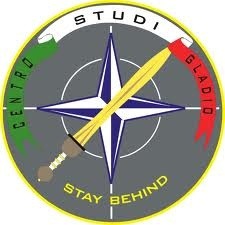
Italy, as I have mentioned, was not the only country in which stay- behind networks were involved in strategy-of-tension operations. Terror operations against the domestic population also took place in Belgium, Turkey, and Greece. As in Italy, the secret armies were trained and equipped by the CIA and its British counterpart, MI6, and operated as a top secret branch of the national military intelligence service. The details of the operations in these three countries are available in my book, NATO’s Secret Armies.39 In the present essay, I have space left only to give a brief discussion of operations in France.
The revelations of Italian Prime Minister Andreotti took Socialist François Mitterrand, the president of France from 1981 to 1995, by surprise. When questioned by the French press in 1990, Mitterrand made attempts to distance himself from the French secret army, claiming it had been closed down long ago. He said: “When I arrived I didn’t have much left to dissolve. There only remained a few remnants, of which I learned the existence with some surprise because everyone had forgotten about them.”40
Italian Prime Minister Andreotti, however, did not appreciate the way in which la Grande Nation tried to play down its role in the stay-behind conspiracy. He mercilessly declared to the press that the French secret army, far from having been closed down long ago, had recently—on October 24, 1990—sent representatives to a secret meeting of the NATO stay-behind council Allied Clandestine Committee (ACC) in Brussels. When this allegation was confirmed, it caused considerable embarrassment in Paris. Mitterrand refused any further comment.
Retired CIA officer Edward Barnes, who during the French Fourth Republic had worked for the CIA in France before leaving the country in 1956, was willing to provide some information. As the fear of the strong French communists persisted, Barnes explained, the French military intelligence service SDECE (Service de Documentation Extérieure et de Contre-Espionnage), under Henri Alexis Ribiere, set up a secret anti-communist army. “There were probably a lot of Frenchmen who wanted to be ready if something happened,” Barnes argued. Recalling his own work in France, he said that a Soviet occupation was the primary motivation of the French secret army, while promoting anti-communist political activity in the country “might have been a secondary consideration.”41
Terrorist Actions in Algeria
In the early 1960s, large segments of the French military and intelligence services started to disapprove strongly of President Charles de Gaulle’s intention to allow Algeria, the former colony, to become an independent country. The secret army, perceiving De Gaulle’s government as an enemy, evidently engaged in strategy-of- tension operations against it. Some “terrorist actions” against de Gaulle and his Algerian peace plan had been carried out by groups that included “a limited number of people” from the French stay- behind network, admitted Admiral Pierre Lacoste, former director of the French military intelligence service (DGSE, formerly called SDECE), in 1990. Lacoste, who resigned in 1985 after the DGSE blew up the Greenpeace ship Rainbow Warrior while it was protesting French atomic testing in the Pacific, argued that despite its links to terrorism, France’s staybehind program was justified by Soviet contingency plans for invasion.42
One officer who promoted strategy-of-tension terror tactics during this period was Yves Guerin-Serac, a Catholic militant anti- communist. A specialist in secret warfare, he had served in Korea, Vietnam, and (as a member of the French 11th Demi-Brigade Parachutiste du Choc) in the war in Algeria. French intelligence service author Roger Faligot called this unit “the iron spear of the secret war in Algeria from 1954 to 1962.”43 By 1954, 300 men of this special force had arrived in Algeria. Most of them had extensive covert action and anti-guerrilla experience, having come directly from Vietnam after France’s defeat at the battle of Dien Bien Phu had led France to give up its attempt to recolonize that country. The mission of Serac and his colleagues was crystal clear: To defeat the Algerian Liberation Front (FLN) in northern Africa by all means after France’s humiliating defeats in World War II and Vietnam. This effort included strategy-of-tension operations designed to discredit the Algerian liberation movement.
After the defeat of the French and Algeria’s declaration of independence in 1962, the secret war did not end for Guerin-Serac, who, together with other officers, felt betrayed by the French government and decided to continue their secret war. Serac knew exactly how a strategy-of-tension operation had to be carried out in order to discredit the communists and the members of liberation movements across the globe. In a November 1969 text, “Our Political Activity,” Serac and other officers stressed that they had to infiltrate the enemy, then carry out atrocities in its name. They wrote:
Our belief is that the first phase of political activity ought to be to create the conditions favoring the installation of chaos in all of the regime’s structures.... In our view the first move we should make is to destroy the structure of the democratic state, under the cover of communist and pro- Chinese activities. Moreover, we have people who have infiltrated these groups and obviously we will have to tailor our actions to the ethos of the milieu—propaganda and action of a sort which will seem to have emanated from our communist adversaries.... That will create a feeling of hostility toward those who threaten the peace of each and every nation, and at the same time we must raise up as defender of the citizenry against the disintegration brought about by terrorism and subversion.44
Italian judge Guido Salvini, who investigated the strategy of tension, found that Serac had indeed carried out the dark strategy-of-tension plans. He wrote:
In 1975 the group of Guerin Serac, together with the American Salby and militant French, Italian and Spanish rightists, organized a series of bomb attacks.... The bombs were planted at Algerian embassies in four different countries, France, Germany, Italy and Great Britain.... In reality the bombings were carried out by the group of Guerin Serac, who thus demonstrated his great camouflage and infiltration capabilities.... The bomb in front of the Algerian embassy in Frankfurt did not blow up, and was meticulously analyzed by the German police.... [I]t is important to notice the complex fabrication of the bomb. It contained C4, an explosive exclusively used by the US forces, which has never been used in any of the anarchist bombings.45
These statements by and about Guerin-Sarac provide undeniable evidence of the fact that secret armies in western Europe engaged in terrorist killings of innocent civilians to achieve political objectives. These secret armies, as we have seen, operated with guidance from the CIA and NATO, hence from US intelligence and military officers. I turn now to the question of strategy-of-tension operations in the United States itself.
The United States
In the United States, the strategy of tension was prominently advocated in the early 1960s by the highest ranking officer in the Pentagon—General Lyman Lemnitzer, chairman of the Joint Chiefs of Staff—as a pretext to convince the US public of the need to invade Cuba and overthrow Castro. Lemnitzer, who died in 1988, had been one of the senior officers sent to negotiate the Italian surrender in 1943 and the German surrender in 1945. After fighting in Korea, he became, in 1960, chairman of the Joint Chiefs of Staff. Following the CIA’s failed Bay of Pigs invasion in 1961, leading generals in the Pentagon, including Lemnitzer, argued that strategy-of-tension techniques should be used against the US population in order to create a pretext for war. Under the name “Operation Northwoods,” they developed a set of combined strategy-of-tension operations designed to shock the US public and discredit Castro.
At the time, President John F. Kennedy and his secretary of defense, Robert McNamara, opposed such operations, which included killing US citizens and involved a large-scale manipulation of the American population. Lemnitzer’s plan was, accordingly, not implemented.46
As with most strategy-of-tension operations, many years went by before the public learned of Operation Northwoods. Thanks to distinguished US researcher James Bamford, the formerly top secret Operation Northwoods documents became known to the public in April 2001, some months before the 9/11 terrorist attacks, when Bamford published his book Body of Secrets: An Anatomy of the Ultra Secret National Security Agency. This was 40 years after the Northwoods plans had been stamped “top secret” inside the Pentagon. The original documents are now available online.47
The Operation Northwoods documents specify how the Pentagon planned strategy-of-tension operations. Among other actions, the US officers suggested developing a fake “Communist Cuban terror campaign in the Miami area, in other Florida cities and even in Washington,” faking a Cuban air force attack on a civilian jetliner, “sink[ing] a boatload of Cuban refugees (real or simulated),” and concocting a “Remember the Maine” incident by blowing up a US ship in Cuban waters and then blaming the incident on Cuban sabotage.
Ever since Bamford published the Operation Northwoods documents, those interested in the strategy of tension have wondered how far certain radical groups within the Pentagon were willing to go and what chance the US public and other nations had of discovering and stopping such plans. Bamford wondered whether Operation Northwoods was the most corrupt plan ever created by the US government, or whether the Gulf of Tonkin incident of 1964—the incident that provoked America’s full-fledged war in Vietnam, which led to the deaths of 56,000 US soldiers and 3 million Vietnamese—had been a typical strategy-of-tension operation designed and carried out by the Pentagon. “[I]n light of the Operation Northwoods documents,” Bamford concluded, “it is clear that deceiving the public and trumping up wars for Americans to fight and die in was standard, approved policy at the highest levels of the Pentagon.”48
Conclusion
The two main arguments against the view that the attacks of 9/11 were influenced by the US government and its military have been a priori arguments. One of these is that civilized Western governments in general, and the US government in particular, would never do such a heinous thing. The other main a priori argument is that if the attacks of 9/11 were carried out by forces within America’s own government, this fact could not have remained secret for this long. The information in this article shows both of these arguments to be dubious at best.
_________________________________________________________________________________________
* Note: This article is taken, with changes and with the permission of author, editors and publisher,
from David Ray Griffin and Peter Dale Scott, eds., 9/11 and American Empire: Intellectuals Speak
Out, Vol. 1 (Olive Branch Press, 2006).
_________________________________________________________________________________________
Dr. Ganser currently heads the Swiss Institute for Peace and Energy Research in Basel, and he is a member of the 9/11 Consensus Panel: consensus911.org
_________________________________________________________________________________________
1 - Wikipedia, “Psychological Warfare”
(en.wikipedia.org/wiki/Psychological_warfare).
2 - During Italy’s Cold War history, the military intelligence service had been
involved in a number of shadow operations that, when discovered, led to public
protests that repeatedly forced the intelligence service to change its label. Created
on March 30, 1949, four years after the defeat of Italy in World War II but a few
days before Italy became a founding member of NATO, the Italian military
intelligence service was first called SIFAR (Servizio Informazioni delle Forze
Armate), then SID (Servizio Informazione Difesa) from 1965 to 1977, and then its
current designation, SISMI (Servizio per le Informazioni e la Sicurezza Militare).
3 - Hugh O’Shaughnessy, “Gladio: Europe’s Best Kept Secret,” Observer, 7 June
1992. Shaughnesssy writes: “They were the agents who were to ‘stay behind’ if the
Red Army overran Western Europe. But the network that was set up with the best
intentions degenerated in some countries into a front for terrorism and far- right
political agitation.”
4 - Newsnight, BBC1 4 April 1991.
5 - Quoted in Senato della Repubblica: Commissione parlamentare d’inchiesta sul
terrorismo in Italia e sulle cause della mancata individuazione dei responsabilii
delle stragi: Il terrorismo, le stragi ed il contesto storico politico (Rome: Redatta
dal presidente della Commissione, Senatore Giovanni Pellegrin, 1995) 261.
6 - Senato della Repubblica 157.
7 - Senato della Repubblica 220.
8 - Newsnight, BBC1 4 April 1991.
9 - Observer, 18 November 1990.
10 - Mario Coglitore, ed., La Notte dei Gladiatori. Omissioni e silenzi della
Repubblica (Padua, 1992) 131.
11 - Leo Müller, Gladio: Das Erbe des Kalten Krieges: Der NATO- Geheimbund und
sein deutscher Vorläufer (Hamburg: Rowohlt, 1991) 27.
12 - Reuters, 12 November 1990.
13 - Franco Ferraresi, “A Secret Structure Codenamed Gladio,” Italian Politics: A
Review 1992: 30. Ferraresi quotes directly from the document that Andreotti handed
over to the parliamentary commission. The Italian daily L’Unita published the
document in a special edition on 14 November 1990. It is also contained in Jean
Francois Brozzu-Gentile, L’affaire Gladio (Paris: Editions Albin Michel, 1994).
14 - Ferraresi 31, quoting directly from the Andreotti document.
15 - Ed Vulliamy, “Secret Agents, Freemasons, Fascists... and a Top-level Campaign
of Political ‘Destabilisation’: ‘Strategy of Tension’ That Brought Carnage and
Cover-up,” Guardian, 5 December 1990.
16 - Italian political magazine Europeo 16 November 1990. Miceli had indeed been
sentenced to go to prison in the 1970s and spent six months in a military hospital. In
1974 the Italian investigating judge, Giovanni Tamburino, in the course of his
investigation into right-wing terrorism in Italy, had taken the unprecedented step of
arresting General Miceli on the charge of “promoting, setting up, and organizing,
together with others, a secret association of military and civilians aimed at
provoking an armed insurrection to bring about an illegal change in the constitution
of the state and the form of government.” (See also the British political magazine
Statewatch, January 1991.) During his trial in November of 1974, Miceli, previously
responsible for the NATO Security Office, angrily confirmed that a special unit did
indeed exist within the military secret service, SID, but that he was not to blame: “A
Super SID on my orders? Of course! But I have not organized it myself to make a
coup d’état. This was the United States and NATO who asked me to do it!” (See
also Brozzu-Gentile 105.) It was the end of his career in the Italian military secret
service. After his time in prison, he became a parliamentarian in 1976 and for the
rest of his life enjoyed parliamentary immunity from prosecution as deputy of the
neofascist Movimento Sociale Italiano (MSI). Reelected twice, he resigned in 1987
on grounds of ill health and died three years later.
17 - As quoted in Ferraresi 31.
18 - Norberto Bobbio, as quoted in Ferraresi 32.
19 - Washington Post, 14 November 1990. The only other article by the Post that
features the keyword “Gladio” appeared on 8 August 1993. A comparison with a
leading British newspaper, the Guardian, which had 39 articles on Gladio during
the same period, indicates how poorly the Gladio phenomenon was covered in the
US press.
20 - Philip P. Willan, Puppetmasters: The Political Use of Terrorism in Italy
(London: Constable, 1991) 28.
21 - Independent, 1 December 1990.
22 - Jonathan Kwitny, “The CIA’s Secret Armies in Europe,” Nation, 6 April 1992:
445.
23 - Senato della Repubblica: Commissione parlamentare d’inchiesta sul terrorismo
in Italia e sulle cause della mancata individuazione dei responsabiliy delle stragi:
Stragi e terrorismo in Italia dal dopoguerra al 1974. Relazione del Gruppo
Democratici di Sinistra l’Ulivo (Rome, June 2000). Quoted as “Italian Senate 2000
report on Gladio and the massacres.”
24 - Quoted in Philip Willan: “US ‘Supported Anti-left Terror in Italy.’ Report
Claims Washington Used a Strategy of Tension in the Cold War to Stabilize the
Centre-Right,” Guardian, 24 June 2000.
25 - Philip Willan, “Terrorists ‘Helped by CIA’ to Stop Rise of Left in Italy,”
Guardian, 26 March 2001. Willan, an expert on US covert action in Italy, published
the very valuable book Puppetmasters (see note 24).
26 - Jeffrey McKenzie Bale, “The ‘Black’ Terrorist International: Neo-Fascist
Paramilitary Networks and the ‘Strategy of Tension’ in Italy, 1968–1974” (Ann
Arbor, Mich.: UMI Dissertation Services, 1996).
27 - Arthur Rowse, “Gladio: The Secret US War to Subvert Italian Democracy,”
Covert Action Quarterly, 49 (Summer 1994).
28 - Times (London), 19 November 1990.
29 - Observer, 18 November 1990.
30 - See Daniele Ganser, NATO’s Secret Armies: Operation Gladio and Terrorism in
Western Europe (London: Frank Cass, 2005).
31 - European, 9 November 1990.
32 European, 9 November 1990. It seems that the NATO official who issued the
correction was Robert Stratford. Cf. Regine Igel, Andreotti: Politik zwischen
Geheimdienst und Mafia (Munich: Herbig Verlag, 1997) 343.
33 - Observer, 18 November 1990.
34 - Letter of Lee McClenny, NATO head of press and media, to the author, dated 2
May 2001.
35 - “Gladio. Un misterio de la guerra fria. La trama secreta coordinada por mandos
de la Alianza Atlantica comienza a salir a la luz tras cuatro decadas de actividad,”
El País, 26 November 1990.
36 - El País article.
37 - Reuters News Service 15 November 1990.
38 - Debates of the European Parliament (official transcripts) 22 November 1990.
39 - See note 31.
40 - Quoted in Brozzu-Gentile 141. Also quoted by the Associated Press 13
November 1990.
41 - Kwitny, “The CIA’s Secret Armies in Europe” 446, 447.
42 - Kwitny.
43 - Roger Faligot and Pascal Krop, La Piscine: Les Services Secrets Francais
1944–1984 (Paris: Editions du Seuil, 1985) 165.
44 - Quoted in Stuart Christie, Stefano Delle Chiaie (London: Anarchy Publications,
1984) 32. Also in Lobster (October 1989) 18. This document was allegedly found in
the former office of Guerain-Serac after the Portuguese revolution of 1974.
45 - Commissione parlamentare d’inchiesta sul terrorismo in Italia e sulle cause
della mancata individuazione dei responsabili delle stragi. 9th session, 12 February
1997 (www.senato.it/parlam/bicam/terror/stenografici/steno9.htm)["Pagina non disponibile"].
46 - Besides not implementing Lemnitzer’s plan, Kennedy transferred him to Europe,
where he served as NATO’s Supreme Allied Commander from January 1963 to July
1969. He was replaced by General Andrew Goodpaster, who served as SACEUR
from 1969 through 1974, during the years when the terrorist operations took place
in Italy.
47 - On the homepage of the National Security Archive here.
48 - James Bamford, Body of Secrets: Anatomy of the Ultra-Secret National Security
Agency (New York: Anchor Books, 2002) 91.
____________________________________________________________________________________________
Professor Ganser’s article is here: journalof911studies.com (.pdf)
URL: http://www.a-w-i-p.com/index.php/2014/06/02/false-flag-attacks-the-strategy

